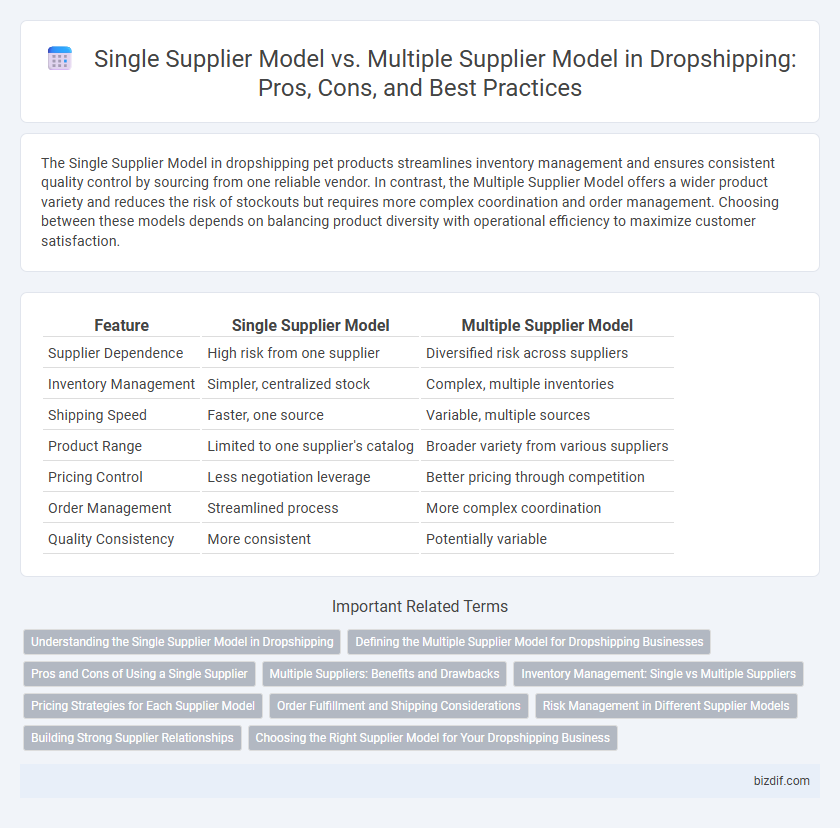The Single Supplier Model in dropshipping pet products streamlines inventory management and ensures consistent quality control by sourcing from one reliable vendor. In contrast, the Multiple Supplier Model offers a wider product variety and reduces the risk of stockouts but requires more complex coordination and order management. Choosing between these models depends on balancing product diversity with operational efficiency to maximize customer satisfaction.
Table of Comparison
| Feature | Single Supplier Model | Multiple Supplier Model |
|---|---|---|
| Supplier Dependence | High risk from one supplier | Diversified risk across suppliers |
| Inventory Management | Simpler, centralized stock | Complex, multiple inventories |
| Shipping Speed | Faster, one source | Variable, multiple sources |
| Product Range | Limited to one supplier's catalog | Broader variety from various suppliers |
| Pricing Control | Less negotiation leverage | Better pricing through competition |
| Order Management | Streamlined process | More complex coordination |
| Quality Consistency | More consistent | Potentially variable |
Understanding the Single Supplier Model in Dropshipping
The Single Supplier Model in dropshipping relies on partnering with one primary supplier to streamline inventory management, order fulfillment, and communication. This model minimizes complexity by centralizing product sourcing, which can enhance consistency in shipping times and product quality. However, dependency on a single supplier increases risk if that supplier faces stock shortages or delays.
Defining the Multiple Supplier Model for Dropshipping Businesses
The Multiple Supplier Model in dropshipping involves partnering with various suppliers to source products, enabling a wider product range and reducing dependency on a single source. This model enhances inventory flexibility and mitigates risks associated with supplier delays or stock shortages. Efficient management of multiple supplier relationships and seamless integration with ecommerce platforms are critical to ensuring reliable order fulfillment and customer satisfaction.
Pros and Cons of Using a Single Supplier
Using a single supplier in dropshipping simplifies inventory management and streamlines communication, reducing order errors and improving fulfillment speed. However, dependence on one supplier increases risks such as stock shortages, limited product variety, and vulnerability to supplier disruptions. Businesses must weigh these factors against the potential cost savings and consistent product quality offered by a single-source supply chain.
Multiple Suppliers: Benefits and Drawbacks
The multiple supplier model in dropshipping offers increased product variety, reduced risk of stockouts, and improved negotiation leverage, enabling sellers to cater to diverse customer demands. However, managing multiple suppliers can lead to complex logistics, inconsistent shipping times, and challenges in maintaining quality control. Effective communication and reliable supplier vetting are essential to maximize the benefits and mitigate the drawbacks in this approach.
Inventory Management: Single vs Multiple Suppliers
The Single Supplier Model simplifies inventory management by centralizing stock control and reducing complexity in order tracking. Multiple Supplier Model, however, demands advanced inventory synchronization systems to handle varied stock levels, shipping times, and product availability from different sources. Efficient integration with supplier databases and real-time updates become crucial for maintaining accurate inventory records in multi-supplier dropshipping setups.
Pricing Strategies for Each Supplier Model
The Single Supplier Model allows for streamlined pricing strategies with consistent markups and simplified negotiation, enabling better volume discounts and predictable profit margins. In contrast, the Multiple Supplier Model requires dynamic pricing tactics to accommodate varied cost structures and fluctuating supplier rates, often leveraging competitive pricing to maximize product variety and minimize stockouts. Optimizing pricing for each model enhances overall profitability by balancing customer demand and supplier constraints effectively.
Order Fulfillment and Shipping Considerations
The Single Supplier Model streamlines order fulfillment by centralizing inventory and reducing shipping complexities, resulting in faster processing and consistent delivery times. In contrast, the Multiple Supplier Model often faces challenges with varied shipping carriers, inconsistent packaging, and longer fulfillment times due to dispersed inventory sources. Efficient communication and tracking systems are critical to managing delays and ensuring customer satisfaction in both models.
Risk Management in Different Supplier Models
The Single Supplier Model in dropshipping consolidates risk around one source, increasing vulnerability to stock shortages and shipping delays. In contrast, the Multiple Supplier Model diversifies risk by spreading inventory and fulfillment across various suppliers, enhancing supply chain resilience and reducing dependency. Employing multiple suppliers allows for better contingency planning and mitigates the impact of individual supplier disruptions on overall operations.
Building Strong Supplier Relationships
Building strong supplier relationships is crucial in both single supplier and multiple supplier dropshipping models, though the approach differs. The single supplier model allows for deeper collaboration and consistent communication, enabling better negotiation on pricing, inventory reliability, and prioritization in order fulfillment. In contrast, the multiple supplier model requires strategic management to maintain trust and transparency across various suppliers, ensuring diverse product availability and minimizing risks from supply chain disruptions.
Choosing the Right Supplier Model for Your Dropshipping Business
Selecting between a single supplier model and a multiple supplier model in dropshipping depends on factors like product variety, risk management, and operational complexity. A single supplier model offers streamlined communication and consistent inventory but risks supply chain disruptions, while multiple suppliers increase product range and reduce dependency but require careful coordination and quality control. Evaluate your business goals, customer expectations, and logistical capabilities to determine the best supplier model for sustainable growth and customer satisfaction.
Single Supplier Model vs Multiple Supplier Model Infographic

 bizdif.com
bizdif.com